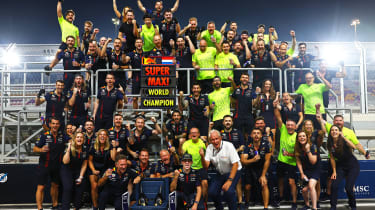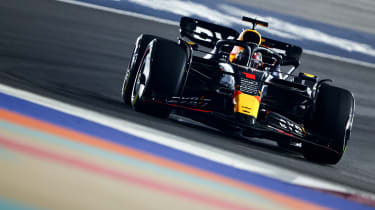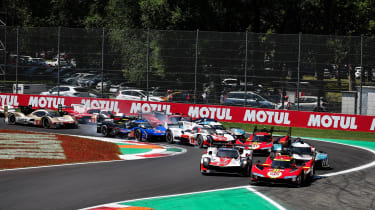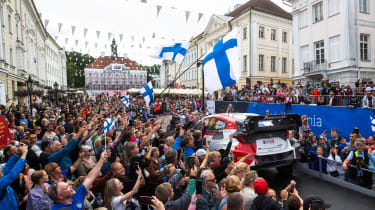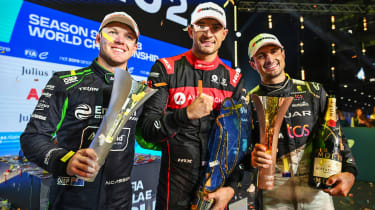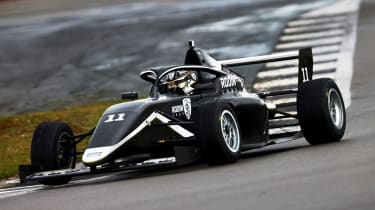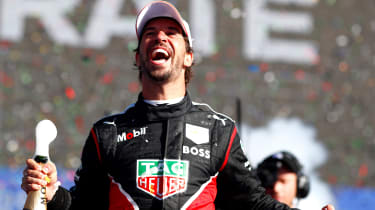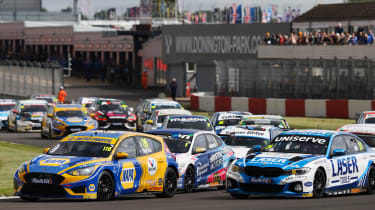Motorsport highlights 2023: 12 amazing months of F1, WEC, WRC, Indycar and more
As records tumbled in F1, there were repeat winners in WEC and WRC, plus a British champion in Formula E
We’ve come to the end of the 2023 motorsport season, and in terms of results it looks eerily similar to 2022. Not only has F1 produced the same champion as last year, so have the pinnacles of both endurance racing and world rallying, too.
But that doesn’t mean the way we arrived at those results wasn’t without drama, intrigue and action – while several long-standing motorsport records were shattered. Here are some of the sporting highlights of the year.
Formula One
Whoever you support in Formula One, it’s impossible not to admire the utter dominance of Max Verstappen. He broke various records through the season on his way to becoming a triple world champion.
Winning 19 of the 22 races this year gave him a win percentage of 86.36 per cent, breaking a record of 75 per cent dating all the way back to 1952 and Alberto Ascari. Beyond that, his 10-win streak from Miami to Monza beat the previous record held by Sebastian Vettel; he led almost 76 per cent of all race laps this year (beating the 71 per cent achieved by Jim Clark in 1963); and he won all 12 races from which he started on pole this year, beating the former record jointly held by Nigel Mansell (1992) and Vettel (2011).
And yes, you could rightly argue that the Red Bull RB19 is one of the fastest racing cars ever; only one off weekend in Singapore plus a superb performance by Ferrari’s Carlos Sainz prevented the Milton Keynes squad from taking a complete clean sweep this year.
The sheer consistency that the triple champion has shown in 2023 has also been drawn into focus by the struggles of team mate Sergio Perez. While the Mexican appeared to be mounting a title challenge early on, Verstappen’s form remained relentless as his team mate faltered. Max’s only error was a slightly clumsy brush with the pit wall as he left his garage during British Grand Prix qualifying, which sums up just how incredible his execution has been.
Beyond the Dutchman’s dominance, there were many fascinating battles. The race for second in the Constructors’ championship went down to the final lap of the final race, with Mercedes pipping Ferrari by just three points. The Ferrari duo of Charles Leclerc and Sainz had fantastic pace all season (with four poles for Leclerc, only Verstappen had a better qualifying record than the Monegasque driver) but poor reliability and questionable tactical decisions cost the team dearly.
From early on in the year, it looked like the Mercedes would not fully bounce back from its 2022 struggles, yet despite a tricky car that rarely showed impressive pace, Lewis Hamilton ground out consistently strong finishes. A pole position at the Hungarian Grand Prix and strong race pace in Austin – the latter proving to be one of the closest battles Max had all season – were his highlights; a somewhat desperate overtaking attempt when he collided with his team mate George Russell at the Qatar Grand Prix was the only blot on his copy book. As for Russell, despite qualifying form on a par with the seven-time champion’s, he struggled a little more in race trim. It led to what Russell himself described as “one of the worst seasons” of his career.
Another of the F1 old guard, Fernando Alonso, had a superb start to the season, but his car’s development didn’t progress as well as some rivals, which caused his challenge for third overall to drop back.
Alonso was in a four-way battle for fourth in the championship with the Ferrari duo and Lando Norris. They were separated by just six points at the end of the year; Alonso pipped Leclerc to fourth on podium countback, with Norris one point further adrift.
Had the McLaren been as competitive in the first half of the season as it was in the run-in, Norris could have been even higher than his fifth-place finish. He took seven podiums, while team mate Oscar Piastri had the best rookie season since Lewis Hamilton in 2007. He bagged two podiums and was one of the few drivers to hold off Verstappen as he won the sprint race in Qatar.
With the regulations and every driver line-up remaining consistent through to next year, we just hope that those battles can be fought alongside Verstappen in 2024, rather than in his mirrors.
WEC
The World Endurance Championship entered a very exciting period in 2023, with new hypercar regulations. A host of new manufacturers, including Cadillac, Ferrari, Peugeot and Porsche, became full-time competitors, but none of them could match the Toyota Gazoo Racing squad over the course of the season.
Superb consistency from the trio of Sebastien Buemi, Brendon Hartley and Ryo Hirakawa was the key to the success of the number eight car; of the seven races this year, they finished in the top two every time but one.
Team mates Mike Konway, Kamui Kobayashi – also the squad’s team boss – and Jose Maria Lopez will be rueing a desperately unlucky Le Mans 24 Hours race. Kobaysahi was an innocent party in a collision that eliminated their Toyota GR010 Hybrid from the race, and the big zero chalked up there proved more costly than anywhere else, because the teams score double points at Le Mans. Otherwise, the number seven car’s results in the rest of the season were worthy of a world title; the trio took four wins – twice as many as their team mates.
Much like Red Bull in F1, Toyota won all but one race in 2023, and again like F1, it was only Ferrari that prevented a clean sweep. In this case, the AF Corse squad managed to spoil the Japanese brand’s party at the biggest race of the year, by winning the 24 Hours of Le Mans. The win at La Sarthe, when the trio of James Calado, Alessandro Pier Guidi and Antonio Giovanazzi emerged victorious, was the first by a Ferrari since 1965.
And if this year wasn’t enough of a battle between the manufacturers, next season is set to become even more competitive. While the championship will sadly lose the Glickenhaus squad, it’ll also see the likes of Alpine, BMW, Isotta Fraschini and Lamborghini entering the fray.
WRC
In an altogether different type of endurance, Toyota proved its mettle in the World Rally Championship by becoming World Champion for the third year in a row; and for the second year running, the best driver was Kalle Rovanperä. The youngest ever WRC champion also became the youngest double champ as he bagged three wins and six podiums. One of the highlights was Rally Estonia, where he took 13 consecutive stage wins.
It was an emotional 2023, with rallying mourning the loss of Gymkhana icon Ken Block and former Citroen, Ford and Hyundai driver Craig Breen. The Irishman had previously worked with co-driver Scott Martin, now with Elfyn Evans, making the Toyota pair’s win in Rally Croatia, just 10 days after Breen’s passing, all the more poignant.
Evans and Martin were the pair who put up the most stubborn opposition to Rovanperä across the course of the 2023 season, with the duo bagging two more victories and another four podiums throughout their campaign. However, when they crashed in the penultimate Central European Rally, it secured the title for Rovanperä.
Besides Evans, one of the few drivers who could consistently match the young Finn’s speed was Sébastien Ogier. Entering only eight of the 13 rallies in ’23, he won three of them, with victory at the season-opening Monte Carlo making him the most successful driver ever on the event, with nine wins. His overall performances were
still enough for fifth place in the standings overall.
Third place went to Hyundai’s Thierry Neuville, with Ott Tänak taking fourth for Ford M Sport – each with two wins. However, there will be a golden opportunity for another driver next year, because Rovanperä has announced that he will only compete on a part-time basis. Does that mean 2024 could be ‘third time lucky’ for Evans to become the first British WRC champ since Richard Burns in 2001?
Formula E
While Formula One might have lacked a British race-winning driver or manufacturer for the first time ever in the sport’s history, 2023 did serve up a home-grown world champion elsewhere. The ninth season of Formula E saw Jake Dennis eventually secure the title after a titanic tussle throughout the year, as he overcame the rapid Kiwis Nick Cassidy and Mitch Evans.
Every driver had plenty to adjust to in the 2022/2023 season, thanks to the introduction of the all-new GEN 3 car. This produced up to 470bhp in qualifying trim – 135bhp up on its predecessor – yet also weighed 60kg less, at 840kg.
At the same time, maximum brake regeneration more than doubled to 600kW. Not only was this enough for over 40 per cent of the energy required to complete a race to be harvested from the motors, but it also provided such strong deceleration that the cars had no rear brake discs at all.
Ultimately, lap times for the latest season were pegged back by regulations imposed on new tyre supplier Hankook; the fresh rubber proved to be incredibly hard, making the cars tricky to drive on the limit. From the 2025/26 season, the tyre supplier will be switched to Bridgestone.
Dennis adapted to these new challenges superbly, and performed consistently strongly throughout the season, making barely a mistake and always on the pace. He took a modest two victories all year – rivals Evans and Cassidy bagged four each – but the Avalanche Andretti driver’s 11 podium finishes were enough to see off Cassidy by 30 points. This included keeping an incredibly cool head during a chaotic London ePrix double-header at the end of the year; the half-in, half- outside track layout around the ExCeL centre became all the more dramatic following a torrential downpour.
As reward for his superb season, Dennis was given a chance to drive for the Red Bull Formula One team in the season-ending test at Abu Dhabi as part of his role as the squad’s simulator driver.
Don’t expect him to appear in F1 just yet, though – the man from Nuneaton has recently signed a multi-year deal with Avalanche Andretti that will keep him with the team beyond 2025.
Indycar
Along with the Monaco Grand Prix and the 24 Hours of Le Mans, the ‘Triple Crown” is completed by the Indianapolis 500. And this year’s event was as dramatic as ever.
It came down to the final lap; a late red flag meant that the race would go green with 249 of the 250 laps completed. At this point, 2022 winner Marcus Ericsson found himself in the lead, but unfortunately that left him almost powerless to hold off the chasing pack at the restart. Despite stern defence, a daring move by Josef Newgarden secured the double Indycar champ his first Indy 500 victory after 11 years of trying.
Although Newgarden had the chance to drive victory lane at the greatest race of the season, Alex Palou topped the standings at the end of the year. The Spaniard repeated his title victory of 2021 to become the sixth multiple champion since the inauguration of the series’ current format in 1996.
Palou inflicted the damage against the competition in the first half of the season and primarily on road courses, with wins at the Indianapolis Road Course, Detroit, Road America and Mid Ohio. In contrast to Palou, Newgarden proved to be the Oval specialist, with wins at the Texas Motor Speedway and a double header in Iowa.
Palou’s closest challenger, however, was Scott Dixon. The six-time champ fell slightly short, but his staggeringly consistent Indycar form continues; he has only failed to finish in the top four three times since 2003. As in Formula E, the other podium places went to New Zealanders; behind Dixon was Scott McLaughlin, the man who switched from the Australian Supercars series full time in 2021 showing amazing pace on street and road courses.
Next season will mark a change in the sport’s technical regulations, with a new hybrid set-up introduced. It’ll take the place of the ‘push-to-pass’ system used by the current cars – essentially a power bump that the drivers can use at their discretion for a limited time through the race. But while the current system adds 60bhp, the capacitor-based hybrid boost will offer up 150bhp.
Our unsung heroes of 2023
Auto Express’s motorsport gurus choose their favourite racers from 2023...
Louis Sharp - F4
By Steve Fowler
It was never in doubt for me, but Louis cut it fine, leaving it until the last race to take the British F4 championship. To be honest, he probably would have won the title last year, had it not been for him being too young to compete in the first few races. And at 16, he’s still some way off being able to take his driving test. That didn’t stop him whizzing me around Thruxton last year in an Abarth 595, where his sheer speed and ability instantly stood out.
This year, though, the Rodin Carlin racer has been at or around the head of the pack in F4 throughout the season, taking a win and second place in the final breathtaking three-race round at Brands Hatch. The British-born New Zealander will, no doubt, move up the ranks next year as he heads towards his ultimate goal – F1. Which just happens to be where another former F4 champion called Lando Norris now races.
Shane van Gisbergen - Supercars/Nascar
By Dean Gibson
Some of the hardest-fought racing you’ll see anywhere in the world is on the Nascar circuit, so it takes a special kind of talent to turn up and win on your race debut. But that’s exactly what New Zealand’s Shane van Gisbergen did this year on the rain-soaked streets of Chicago.
If you’ve kept in touch with Australian touring car racing, then you’ll know who van Gisbergen is – basically a hugely talented racing driver. He’s a triple V8 Supercars champion, and has won the legendary Bathurst 1,000 touring car race three times, too. Not only that, but he’s also won the Bathurst 12 Hours endurance race for GT3 sportscars, and has proved himself to be pretty handy in a variety of GT machinery racing over here in Europe, too.
But it was his exploits in Chicago that really put van Gisbergen on the map. He gave the regulars a masterclass in hustling a big, heavy stock car around a concrete-lined track. It came as a shock to the Nascar fraternity, but with Australian Supercar races taking place on the street circuits of Surfers Paradise and Adelaide (both places where SvG has won in the past), it was second nature for the Kiwi.
It stood him in good stead, too, because in 2024 he’ll be heading Stateside for more Nascar exploits, and hopefully more of his incredible talent will shine through.
Antonio Felix da Costa - Formula E
By Alastair Crooks
My colleagues have singled out fantastic drivers based on their performances across a whole season, but I’m picking an individual based on one single manoeuvre – and possibly the best overtake we saw all year.
Formula E isn’t exactly short of close racing; longer braking distances and minimal downforce levels give drivers many more passing opportunities than
in Formula 1. Take this year’s Monaco Grand Prix for example. With 22 on-track overtakes in 71 laps, it had the most action in an F1 race at the Principality since 2011, yet the Monaco ePrix served up 114 passes in just 29 laps.
But the best came from Antonio Felix da Costa on the final lap of the Cape Town ePrix. Chasing former team mate Jean-Eric Vergne for the lead, the season six champion got a strong drive off the tight turn seven, and heading towards the 140mph turn eight, he squeezed alongside Vergne and hung his Porsche out around the outside of the right hander before darting left for turn nine, with millimetres between himself, Vergne’s DS Penske and the wall.
It secured victory for what would prove to be his only win of the season, and treated us all to one of the most exciting motorsport moments of 2023.
Ash Sutton - BTCC
By Alex Ingram
Ash Sutton has now won an incredible four championships in his eight years of BTCC racing, making him the joint most-successful driver in the series’ history, alongside Colin Turkington and Andy Rouse.
This year saw the 29-year-old Briton take the title in convincing fashion, eventually seeing off last year’s winner, Tom Ingram, by some margin. Of the 30 races in this year’s calendar, Sutton won 12 of them and stood on the podium for two out of every three rounds.
Back in 2022, he made the switch to Napa Racing and a new car – the Ford Focus ST – but ended up losing the title to Tom Ingram by a mere 12 points. This season, he was absolutely determined to go one better.
The BTCC is changing its rules and regulations for next year, however, which could make Sutton’s title defence much more difficult. The hybrid system that was introduced to the field in 2022 will receive a bump up in power by 30bhp.
Given that those lower down on the grid can use the electrical boost for longer during qualifying sessions, we should see the field bunch up and make front runners fight harder to get into the latter stages of qualifying.
Just follow the link for the rest of our 2023 Review of the Year pages...
Find a car with the experts


